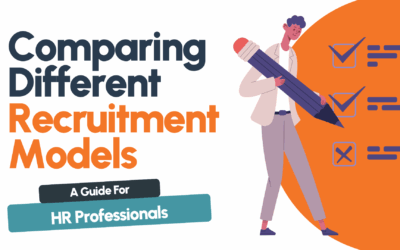Increase Your Talent Pool up to Tenfold with Skills-First Hiring
In an era dominated by daily headlines spotlighting the integration of robots and artificial intelligence across diverse industries, the prevailing talent shortage might seem less evident on the surface. But hiring skilled workers is undoubtedly a challenging endeavour in today’s job market.
As if to accentuate this challenge, numerous talent reports reaffirm this reality:
Why Skilled Talent Is Scarce in Today’s Market
A staggering 77% of employers globally struggle to find the skilled workforce they require in 2023 marking a significant increase from the 35% reported a decade ago.
Based on the latest data released by Manpower. Communication services, energy and utilities, healthcare, life sciences, and information technology roles are among the most difficult to fill.
How the Talent Deficit Will Impact Your Hiring Strategy:
Projections estimate a deficit of 85.2 million workers by 2030.
Governments and organisations must make talent strategy a key priority. (Korn Ferry) Highly skilled workers are in short supply on a global level across all sectors, industries and geographical locations.
As the state of talent acquisition feels uncertain, top recruiters and organisations are looking for strategic solutions. The reality suggests a need for transformation as talent shortages are projected to increase over the next decade.
Why Traditional Hiring Methods No Longer Work
In confronting this hiring crisis, it’s evident that a transformation is overdue. While talent and skills are indeed available, conventional recruitment methodologies struggle to cut through the noise. To address this, a shift in mindset is essential, heralding the era of skills-first hiring.
What Is Skills-First Hiring and Why It Matters
Skills-first hiring isn’t a magical fix for all recruitment issues but it is imperative in closing the talent gap in today’s job market. Organisations must adapt to new strategies to improve their hiring outcomes.
How to Reimagine Recruitment with a Skills-First Approach
The mainstream hiring process, it must be admitted, isn’t optimally designed to spot talent. The conventional way of sourcing, assessing, and shortlisting candidates fixates heavily on elements that indirectly represent the necessary skills. This often involves scanning CVs, conducting interviews, and making assumptions based on previous roles and experiences.
However, this method excludes a substantial pool of potential talent. The fixation on conditions like years of experience or specific job titles creates unnecessary barriers.
Skills-First vs Traditional Hiring: Key Differences
Skills-first hiring stands as a radical departure from the traditional process, focusing on a candidate’s skills that lead to success. By discarding certain criteria and priorities that once dominated, this approach expands the talent search to a diverse audience.
According to LinkedIn, adopting a skills-first approach can potentially increase the talent pool up to tenfold.
Skills-First Hiring: Practical Implementation Guide
Implementing Skills-First Hiring: To truly embrace skills-first hiring, several steps must be taken to overhaul the hiring process.
How to Write Inclusive Job Descriptions for Skills-Based Hiring
Educational Requirements: Consider eliminating mandatory educational requirements, as 70% of jobs in the U.S. demand a bachelor’s degree, while only 37% of the workforce possesses one.
Years of Experience: Avoid specifying a range of years of experience, as it can be arbitrary and discriminatory.
Sectoral Experience: Rethink the necessity of sectoral experience, as it may overlook candidates with essential skills.
How Talent Advisory Can Improve Skills-First Hiring Decisions
Job Title Searches: Instead of relying solely on job titles, perform holistic profile searches for better results.
Related Skills: Utilise tools like LinkedIn to discover related in-demand skills for various roles.
AI and Synonyms: Employ generative AI to craft search strings with synonyms for your target skills.
Leveraging Talent Advisory
Data-Driven Decisions: Skills-first hiring might not be suitable for all roles; use data to assess feasibility. Utilise the expertise and guidance provided by professionals in the field of talent management and recruitment. Use their insights & recommendations to make informed decisions about hiring, skill assessment, and updating your talent acquisition processes.
Examples: Showcase instances where candidates succeeded despite lacking traditional qualifications.
Focus on Weaknesses: Understanding the skills lacking in underperformers can guide your skills-first search, these are the skills you need to be looking for with new candidates!
Free Masterclass Webinar:
Best Tools and Methods for Skills-Based Candidate Assessments
Replacing Degrees with Assessments: Employ online assessments for specific hard skills, eliminating degree requirements.
Assessing Soft Skills: AI-powered platforms like Pymetrics assess crucial soft skills for role success.
Promoting Skill Development: Discourage mandatory skills by emphasising that many skills can be developed in weeks or months.
Interviewing for Skills: Techniques that Work
Behavioural Interviewing: Structure interviews with TMAAT (tell me about a time) questions, ranking answers against predefined criteria.
Understanding the How: Delve into the candidate’s approach and methodology.
Situational Questions: Pose hypothetical scenarios to gauge problem-solving under different constraints.
Upskilling for Success: Learning and Development Tips
Skill Learning Time: Distinguish between skills that take weeks versus those requiring years to develop.
Mastery vs. Competence: Differentiate between achieving competence and mastery in certain skills.
Utilising L&D Resources: Explore available courses and tools to fill skill gaps and support candidates’ growth.
How to Unlock Internal Talent Through Skills Development
Valuing Internal Talent: Internal hires tend to perform better and cost less than external hires.
Tracking Internal Talent: Maintain awareness of internal talent’s evolving skill sets.
Strategic Workforce Planning: Anticipate future skill needs and develop internal talents accordingly.
Ready to tap into untapped talent?
Our embedded recruiters can help you implement skills-first hiring strategies that expand your talent pool fast.
The Future of Hiring: Why Skills-First is the Way Forward
Amid the challenges of the present hiring landscape, change is happening. Notably, job postings on LinkedIn demanding degrees have dropped by 5% in the past year, reflecting evolving attitudes.
By adopting skills-first hiring, organisations can diversify their talent pool, enhance candidate quality, and bolster their pipeline. As hiring adapts to a skills-centric approach, the potential for better matching talent to roles becomes more promising.
For more information on how partnering with Rent a Recruiter can help drive your companies growth, contact our team today for a friendly chat.
Explore our FAQs on Skills-First Hiring
What is skills-first hiring?
Skills-first hiring is an approach that prioritises a candidate’s skills over traditional qualifications like degrees or job titles.
Why is skills-first hiring important?
Traditional hiring methods may exclude qualified candidates. Skills-first hiring widens the talent pool and identifies skills necessary for success.
How does skills-first hiring affect job descriptions?
Skills-first job descriptions focus on necessary skills rather than educational requirements or arbitrary experience ranges.
Can soft skills be assessed effectively?
Yes, emerging AI platforms can assess soft skills required for different roles.
What's the impact of skills-first hiring on internal mobility?
Skills-first hiring encourages internal talent development, minimising the need for expensive external hires.
Hiring is effortless with Rent a Recruiter. Our global Talent Acquisition service specialises in IT, Engineering, Manufacturing, Construction, Finance, and Healthcare. Embedded recruiters integrate into your team, focusing solely on filling your open roles as your business grows.
For more information our recent podcast with Dr John McMackin offers insights into Skills-First Hiring.
For a deeper exploration of these concepts, refer to Dr. John McMackin’s research paper, “Skills-First HR: A Key Enabler of Future Global Strategy“


